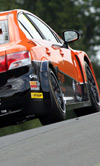Ceramic-coated exhausts
 The subject of the 'management' of heat as concerns race engine exhausts is largely a matter of containment. We have covered the subject briefly before in RET-Monitor articles, and have discussed the advantages of keeping the heat in the exhaust rather than having it radiated to the outside world via the engine bay, which contains lots of electronic components that can object to becoming too hot. Heat radiated to the engine structure and the gearbox can lead to the need for greater cooling capacity; and this has an aerodynamic penalty. Finally, heating of the inlet system means that the intake air is increased in temperature, thus lowering its density. This leads to a loss of volumetric efficiency which hurts the performance of the vehicle by lowering the power output of the engine.
The subject of the 'management' of heat as concerns race engine exhausts is largely a matter of containment. We have covered the subject briefly before in RET-Monitor articles, and have discussed the advantages of keeping the heat in the exhaust rather than having it radiated to the outside world via the engine bay, which contains lots of electronic components that can object to becoming too hot. Heat radiated to the engine structure and the gearbox can lead to the need for greater cooling capacity; and this has an aerodynamic penalty. Finally, heating of the inlet system means that the intake air is increased in temperature, thus lowering its density. This leads to a loss of volumetric efficiency which hurts the performance of the vehicle by lowering the power output of the engine.
The Toyota Avensis NGTC (Next Generation Touring Car) campaigned by Frank Wrathall Jnr in the British Touring Car Championship benefits from well planned containment of heat. It's one of the strongest NGTC-specification cars, often getting on the podium ahead of most of the supposedly superior S2000-specification cars. Such is the speed of the NGTC cars that S2000 drivers are calling for them to be slowed by changes to the rules.
The engine in the Avensis was developed by Warwickshire-based X-CTechR, which gave careful thought to the heat radiated from the exhaust system of the turbocharged four-cylinder engine. Technical director Mark Faulkner says, "Turbocharged application demands specific attention to thermal management to achieve optimum performance." In line with this statement, X-CTechR turned to Zircotec to coat both the exhaust manifold and downpipe with its ceramic coating.
The coating appears to work very well, with Faulkner explaining, "On the dyno the ceramic-coated exhaust gave an improvement in turbocharger response, as more energy was retained within the exhaust rather than radiated as heat." The main criticism of many turbocharged engines is a lack of instant response to changes in throttle position. In race series with more liberal regulations than the BTCC, and bigger budgets, specific anti-lag measures are used, which can involve deliberate combustion of fuel within the exhaust system or to manipulate the throttle independently of pedal position in order to maintain a certain mass flow rate through the turbine.
The BTCC rules, sensibly in these current days of financial insecurity, are looking to establish rules that don't require excessive development budgets. In this context, the use of ceramic-coated exhausts is a sensible step in minimising turbo lag.
By keeping the maximum amount of energy within the exhaust flow, the exhaust turbine is able to accelerate the compressor with the minimum of delay.
While improved turbocharger response is a laudable aim in itself, touring car engines have to operate within a small engine bay. Therefore, under-bonnet temperatures can be a problem. The ceramic exhaust coating also paid off in this respect. Faulkner confirms, "In the vehicle a significant reduction in under-bonnet temperatures was achieved with the ceramic-coated exhaust. This contributes to reduced air intake temperatures, releasing more power."
Fig. 1 - The Toyota Avensis NGTC car benefits from ceramic-coated exhausts (Courtesy of Propel Technology/Zircotec)
Written by Wayne Ward